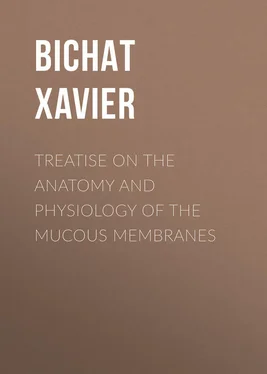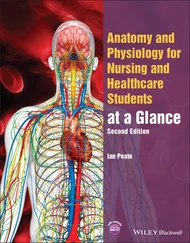Xavier Bichat - Treatise on the Anatomy and Physiology of the Mucous Membranes
Здесь есть возможность читать онлайн «Xavier Bichat - Treatise on the Anatomy and Physiology of the Mucous Membranes» — ознакомительный отрывок электронной книги совершенно бесплатно, а после прочтения отрывка купить полную версию. В некоторых случаях можно слушать аудио, скачать через торрент в формате fb2 и присутствует краткое содержание. Жанр: foreign_antique, foreign_prose, на английском языке. Описание произведения, (предисловие) а так же отзывы посетителей доступны на портале библиотеки ЛибКат.
- Название:Treatise on the Anatomy and Physiology of the Mucous Membranes
- Автор:
- Жанр:
- Год:неизвестен
- ISBN:нет данных
- Рейтинг книги:5 / 5. Голосов: 1
-
Избранное:Добавить в избранное
- Отзывы:
-
Ваша оценка:
- 100
- 1
- 2
- 3
- 4
- 5
Treatise on the Anatomy and Physiology of the Mucous Membranes: краткое содержание, описание и аннотация
Предлагаем к чтению аннотацию, описание, краткое содержание или предисловие (зависит от того, что написал сам автор книги «Treatise on the Anatomy and Physiology of the Mucous Membranes»). Если вы не нашли необходимую информацию о книге — напишите в комментариях, мы постараемся отыскать её.
Treatise on the Anatomy and Physiology of the Mucous Membranes — читать онлайн ознакомительный отрывок
Ниже представлен текст книги, разбитый по страницам. Система сохранения места последней прочитанной страницы, позволяет с удобством читать онлайн бесплатно книгу «Treatise on the Anatomy and Physiology of the Mucous Membranes», без необходимости каждый раз заново искать на чём Вы остановились. Поставьте закладку, и сможете в любой момент перейти на страницу, на которой закончили чтение.
Интервал:
Закладка:
Xavier Bichat
Treatise on the Anatomy and Physiology of the Mucous Membranes / With Illustrative Pathological Observations
THE TRANSLATOR'S PREFACE
The works of no medical writer deserve a more attentive perusal than those of the illustrious Bichat. Erudite, observant, and industrious, he, at an early age, reared a monument of science, which will perpetuate his name and matchless talents. From the rich treasures he has left, the Translator presumes to present this Treatise in an English costume. Where all is excellent it is difficult to make a satisfactory selection; yet this portion of the author's productions merits the particular attention of medical students and practitioners in general, as it leads to the knowledge of the structure and economy of that part of the animal organization, which, more than any other, is subject to morbid affections.
The aim of the Translator has been faithfulness, clearness, and conciseness, rather than elegance: how he has fulfilled his intention he must leave to the decision of the candid Reader.
Saffron Walden, July 1, 1821.SECTION I.
OF THE SITUATION AND NUMBER OF MUCOUS MEMBRANES
1. The Mucous Membranes occupy the interior of those cavities, which, by various openings, communicate with the skin. Their number, at the first view, appears very considerable; for the organs within which they are reflected are numerous. The stomach, bladder, urethra, uterus, ureters, the intestines, &c., borrow from these membranes a part of their structure: nevertheless, if it be considered, that they are continuous throughout, that everywhere they are observed to be extended from one organ to others, arising, as they did at first, from the skin, their number will appear to be singularly limited. In fact, in thus contemplating them, not as insulated in each part, but as continued over various organs, it will appear that they are reducible to two general surfaces.
2. The first of these two surfaces, entering by the mouth, nose, and anterior surface of the eye, (1) lines the first and second of these cavities: from the first it extends into the excretory ducts of the parotid and submaxillary glands; from the other it is continued into all the sinuses, it forms the tunica conjunctiva, descends by the puncta lacrymalia through the canal and lacrymal sac to the nose. (2) It descends into the pharynx, and there furnishes the inner surface of the Eustachian tube, and thence it penetrates and lines the internal ear. (3) It sinks into the trachea, and spreads itself over all the air passages. (4) It enters the œsophagus and stomach. (5) It extends into the duodenum, where it furnishes two branches, one destined to the ductus communis choledochus, to the numerous rami of the hepatic duct, to the cystic duct and gall bladder; the other to the pancreatic duct and its various ramifications. (6) It is continued into the small and large intestines, and finally terminates at the anus, where it is identified with the skin.
3. The second general mucous membrane enters, in men, by the urethra, and thence spreads from one part through the bladder, ureters, pelves, calices, papillæ, and uriniferous tubes; from the other it sinks into the excretory ducts of the prostate gland, into the ejaculatory ducts, the vesicula seminales, the vassa defferentia, and the infinitely convoluted branches from which they arise. In women, this membrane enters by the vulva, and from one part penetrates the urethra, and is distributed, as in men, through the urinary organs; from the other part it extends into the vagina, which it lines, as it also does the uterus and the fallopian tubes, and through the apertures at the extremities of these ducts it comes in contact with the peritoneum. This is the only example in the economy, of a communication between the mucous and serous surfaces.
4. This manner of describing the track of the mucous surfaces by saying that they extend, sink, penetrate, &c., from one cavity to another, is certainly not conformable to the march of nature, which forms in each organ the membranes that belong to it, and does not thus extend them from one to the other; but our manner of conceiving is best accommodated by this language, of which the least reflection will rectify the sense.
5. In thus bringing all the mucous surfaces to two general membranes, I am supported, not only by anatomical inspection, but pathological observation also furnishes me with lines of demarcation between the two, and with points of contact between the different portions of the membranes of which each is the assemblage. In the various sketches of epidemic catarrhs made by authors, we frequently see one of these membranes has been affected throughout its extent, whilst the other, on the contrary, has remained untouched. It is not uncommon to observe a general affection of the first, viz. that which extends from the mouth, nose, and anterior surface of the eye, into the alimentary canal and bronchi. The last epidemic observed at Paris, with which M. Pinel was himself affected, bore this character: that of 1761, described by Rayons, presented the same feature: that of 1732, described in the Memoirs of the Edinburgh Society, was remarkable for a like phenomenon. Now we do not see at the same time a corresponding affection in the mucous membrane which spreads over the organs of urine and of generation. Here is, therefore, (1) an analogy between the different portions of the first, by the uniformity of the affection; (2) a line of demarcation between them, by the healthy state of the one and the disease of the other.
6. We observe also, that irritation on any one point of these membranes frequently produces a pain in another point of the same membrane, which is not irritated; thus a stone in the bladder causes a pain at the end of the glans, worms in the intestines produce an itching at the nose, &c. &c. Now in these phenomena, which are purely sympathetic, it is extremely rare that the partial irritation of one of these two membranes produces a painful affection in a part of the other.
7. We ought, therefore, from inspection and observation, to consider the mucous surface in general as formed by two grand membranes, spread over several organs, and having no communication with each other but by the skin, which is intermediate, and which, being continuous with both, thus concurs with them to form a general membrane, entire throughout, enveloping the exterior of the animal, and extending to the interior over most of its essential parts. It should seem, that there exists important relations between the internal and external portions of this unique membrane, and this we shall soon be shown by ulterior researches.
SECTION II.
OF THE EXTERIOR ORGANIZATION OF MUCOUS MEMBRANES
8. Every mucous membrane presents two surfaces; the one adhering to the adjacent organs; the other free, beset with villosities, and always moist with a mucous fluid: each of them deserves a particular attention.
9. The adherent surface is attached to muscles almost throughout its extent. The mouth, the pharynx, the whole of the alimentary canal, the bladder, the vagina, the uterus, and part of the urethra, &c. present a muscular bed, embracing the exterior of their mucous coat. In animals that have the panniculus carnosus, this disposition perfectly coincides with that of the skin, which, as we shall see, is in other respects analogous in structure to mucous membranes. In man the cutaneous organ presents here and there traces of this exterior muscle, as we observe in the platysma myoides, the palmaris brevis, the occipito frontalis, in most of the muscles of the face, &c. This disposition of mucous membranes places them under the influence of those habitual changes of contraction and dilatation, which are favourable to their secretion, and various other functions.
Читать дальшеИнтервал:
Закладка:
Похожие книги на «Treatise on the Anatomy and Physiology of the Mucous Membranes»
Представляем Вашему вниманию похожие книги на «Treatise on the Anatomy and Physiology of the Mucous Membranes» списком для выбора. Мы отобрали схожую по названию и смыслу литературу в надежде предоставить читателям больше вариантов отыскать новые, интересные, ещё непрочитанные произведения.
Обсуждение, отзывы о книге «Treatise on the Anatomy and Physiology of the Mucous Membranes» и просто собственные мнения читателей. Оставьте ваши комментарии, напишите, что Вы думаете о произведении, его смысле или главных героях. Укажите что конкретно понравилось, а что нет, и почему Вы так считаете.












